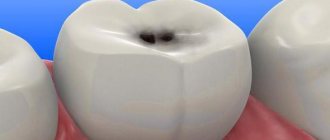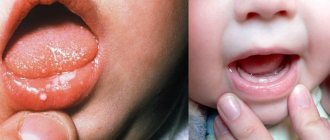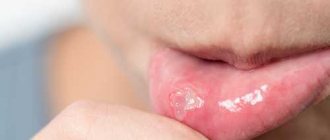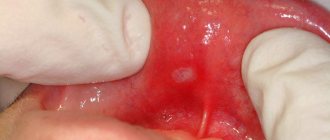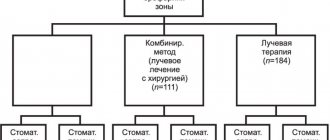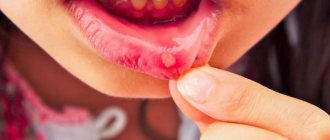Classification of gingivitis according to intensity
- easy
- average
- heavy
The severity of the flow is determined3:
The degree of manifestation of general symptoms - weakness, fever, the presence of enlarged lymph nodes. Changes in condition are also reflected in blood tests. With a mild form, the temperature rises to 37.5°C, with a moderate form up to 38°C, with a severe form - up to 40°C.
Causes of ulcerative-necrotizing gingivitis
Ulcerative-necrotizing gingivitis is caused by fusobacteria and spirochetes. Most often it develops as a complication of catarrhal gingivitis, but it can also be an independent disease. It develops with poor oral hygiene against the background of a sharp decrease in immunity.
General factors
Common factors leading to the onset of the disease are stress, severe fatigue, infectious diseases, and hypothermia. More often the disease is observed in people with diseases of the digestive, endocrine and respiratory systems, heart and vascular diseases. Inadequate and unhealthy diet also increases the risk of developing ulcerative gingivitis. Taking certain medications can also lead to this disease.
Local factors
- Poor oral hygiene In this case, plaque accumulates on the teeth and stones form. With ulcerative necrotic gingivitis, not only ordinary microorganisms accumulate, but also spirochetes.
- Presence of other oral diseases Ulcerative gingivitis can occur as a complication of catarrhal gingivitis and herpetic stomatitis.
- Permanent gum injury For example, old fillings, crowns, dentures.
- Wisdom teeth eruption
- Multiple caries, as it increases the number of pathogens in the mouth
- Injury to the gums by the sharp edges of a carious cavity
- Oral surgery, including complex tooth extraction4
Vincent's stomatitis
Dental Clinic of New Solutions (St. Petersburg) provides its patients with a wide range of services for organizing the treatment of oral diseases.
You can sign up for a free dental consultation by calling: +7 +7
The French physician Hyacinthe Vincent (1862 - 1950) described a condition observed in front-line soldiers (des poilus), "trench mouth", later called Vincent's angina
.
Synonyms and names of related states are also used:
- Vincent's stomatitis
- Vincent's gingivitis
- acute ulcerative necrotic stomatitis Botkin - Simanovsky - Plaut - Vincent,
- fusospirillosis.
Causes of Vincent's stomatitis
The disease is caused by a symbiosis of the spindle-shaped rod and the spirochete (Borrelia) Vincent. These opportunistic microbes, facultative saprophytes, are present in small quantities in all residents at the periodontal junction.
With unfavorable cofactors, such as chronic hypothermia, malnutrition, hypovitaminosis, chronic poisoning (tobaccoism, alcoholism, drug addiction, substance abuse, salts of heavy metals), the presence of tartar (calculus), constant injury to the gums and mucous membranes with defective dental prostheses that erupt and stand outside the arch third molars.
A special role in the development of Vincent's angina
Insufficient hygiene or its complete absence plays a role in the disease.
Vincent's stomatitis
often accompanies or is a complication of other diseases or conditions:
- viral infections,
- acute (flu, herpes) and chronic (infectious mononucleosis),
- exudative erythema multiforme,
- cancer,
- radio and chemotherapy.
Symptoms of Vincent's stomatitis
Symptoms include:
- bleeding and sore gums,
- halitosis (bad breath);
- enlargement, hardening and tenderness of regional lymph nodes;
- signs of general intoxication.
The blood test showed slight leukocytosis, a shift of the formula to the left, a moderate increase in ESR, and in severe cases - toxicogenic granularity of neutrophils.
A biopsy reveals the presence of specific pathogens and the presence of signs of a nonspecific inflammatory process.
Beginning as gingivitis or limited tonsillitis, the process can reach deep and widespread necrotic lesions, down to the bone.
Sometimes, in the absence of adequate treatment, the process can become chronic.
Vincent's ulcerative necrotizing stomatitis
differentiate from HIV infection, secondary syphilis, scorbutus, leukemia, poisoning with salts of heavy metals.
Treatment of Vincent's gingivitis
An important condition for successful treatment of stomatitis is the elimination of local causes:
- oral sanitation,
- removal of traumatic dental prostheses,
- third molars,
- removal of tartar.
To reduce pain during the treatment of Vincent's gingivitis, painkillers are prescribed.
Also, during complex treatment, a set of medications is prescribed:
- broad-spectrum antibiotics,
- metronidazole,
- rinsing with antiseptic solutions (0.05 - 0.2%) chlorhexidine solution, 1 - 2% hydrogen peroxide solution).
- To improve the healing of the mucous membrane, stimulants of reparative processes in tissues and drugs with keratoplastic action are prescribed (solcoseryl, vitamin A, sea buckthorn oil, rosehip oil, sodium olefenamate, metacil, Kalanchoe juice, aloe).
Symptoms of necrotizing ulcerative gingivitis
The disease develops quickly and rapidly, its symptoms appear very clearly.5,6
- Severe pain that gets worse with the slightest touch or temperature changes
- Swelling of the gums
- Sensitivity of the mucous membrane
- Spontaneous bleeding gums
- The tongue is covered with a green, yellow coating
- Ulcers appear on the surface of the gums, covered with a gray coating.
- A sharply unpleasant, strong odor from the mouth that does not go away even when brushing your teeth
- Increased temperature, weakness, fever
- Necrosis of gum tissue
- Brushing teeth and eating food is difficult
- Lymph nodes are enlarged
- Aches, muscle pain
Diagnosis of necrotizing ulcerative gingivitis
Diagnosis is made through the clinical manifestations of necrotizing ulcerative gingivitis.7,8
During the examination and questioning, the dentist identifies poor hygiene, bleeding gums, poor general condition and the absence of gum pockets (impaired attachment of the gum to the tooth). Be sure to take a panoramic photograph of all teeth to distinguish ulcerative gingivitis from periodontitis.
Additionally, bacteriological examination and the ELISA method can be carried out to confirm the diagnosis, determine the level of immunoglobulins and select appropriate treatment tactics.
It is important to distinguish ulcerative gingivitis from immunodeficiency conditions and blood diseases. For this purpose, if necessary, other tests may be prescribed.
Treatment of ulcerative-necrotizing gingivitis
At the first signs of illness, consult a doctor immediately!
Treatment of ulcerative gingivitis is always complex:
- Anesthesia of the oral cavity with sprays, gels, solutions. With ulcerative gingivitis, this stage is extremely important, since the pain is quite severe.
- Removing the inflammatory process. To do this, use gentle methods to remove plaque and tartar, and be sure to prescribe a course of rinsing with antiseptics for up to two weeks. It is during this visit to the doctor that material is taken for bacteriological examination.
- Removal of general symptoms - fever, headache, for this purpose analgesics and antipyretics are prescribed.
- Destroying pathogenic bacteria, for this purpose antibacterial or antimicrobial drugs are prescribed. (Important! Prescribed strictly by your doctor!)
- Vitamin therapy – to increase the body’s overall resistance to harmful factors.
- During treatment, it is recommended to eat non-irritating foods with sufficient calorie content and not to use spices.
- Treatment of general diseases together with a therapist, gastroenterologist and other specialists.
- After acute inflammation subsides, epithelializing drugs are prescribed (to stimulate tissue healing), professional hygiene, treatment of caries and its complications, removal of wisdom teeth, fillings and crowns (if necessary).
In case of ulcerative gingivitis, it is necessary to strictly follow all the doctor’s recommendations, otherwise complications may arise, and the disease may become chronic.
Removal of dental plaque is carried out under local anesthesia of the gums, using antiseptic drugs, only with the help of hand instruments.
Medicinal preparations containing metronidazole and chlorhexidine are applied to the ulcers, cleared of plaque with special enzymes. These drugs are designed to destroy pathogenic microorganisms, but they should be used only as prescribed by a doctor to avoid complications.
To relieve the inflammatory reaction, local applications with an NSAID solution can be applied for 10-15 minutes.
Treatment of gingivitis –
Treatment of catarrhal gingivitis will be quick and effective if 3 conditions are met. Firstly, treatment should primarily be aimed at removing microbial plaque and hard tartar (as the cause of inflammation). Secondly, anti-inflammatory therapy, which may include various rinses and special gels for gums. The third point is the normalization of oral hygiene.
A course of anti-inflammatory therapy can be carried out at home without any problems, but removing a layer of tightly attached microbial plaque and tartar from the surface of the teeth is impossible without visiting a dentist. The fact is that with the help of a regular toothbrush and paste, only “freshly formed” soft microbial plaque is effectively removed. But in the absence of regular hygiene, soft plaque quickly undergoes mineralization by calcium and phosphorus salts (contained in saliva), and turns into tartar.
Partial mineralization of soft microbial plaque occurs on average within 10-16 hours, i.e. it is during this time that soft plaque hardens and becomes tightly attached to the tooth. This is how hard dental deposits gradually form (Fig. 7-8), which can no longer be removed simply by brushing your teeth with a brush and paste. If you start using antiseptic and anti-inflammatory agents for the gums without removing the dental plaque that caused the inflammation of the gums, the effect of the treatment will be short-lived, and the inflammation itself will become chronic.
What does hard dental plaque look like?
Conclusions: please note that dental deposits can be not only clearly visible supragingival (as in Fig. 7-8), but also subgingival, which are located slightly below the gum level. Typically, such deposits can be suspected in the presence of swelling, cyanosis and bleeding of the gums (interdental papillae) - in the visible absence of microbial plaque or dental deposits in the area of the necks of the teeth. Once again, subgingival tartar can be identified and removed only by a dentist.
DETAILED TREATMENT SCHEME –
As we said above, treatment for gingivitis consists of professional teeth cleaning at the dentist, a course of anti-inflammatory therapy, and, no less important, teaching the patient about proper oral hygiene.
The author of the article has more than 10 years of experience as a periodontist, and therefore our recommendations really work (state-issued documents on advanced training in the Periodontology program can be viewed in the editorial section).
1) Removal of dental plaque –
There are several methods for removing dental plaque, but given that with gingivitis the gums are inflamed and usually bleed, it is best to use ultrasonic teeth cleaning (Fig. 9). A special attachment creates ultrasonic vibrations and breaks the attachment of dental plaque to the surface of the tooth enamel. Usually the procedure takes from 30 to 60 minutes (depending on the amount of dental plaque). The procedure is usually painless, but can be performed under anesthesia if desired. Below is a video of this procedure.
At the end of the visit, the dentist will first treat your gums with an antiseptic, and then apply an anti-inflammatory gel to it. A good dentist will then offer to teach you how to properly use a toothbrush and floss, and will also prescribe you a course of home anti-inflammatory therapy. Believe me, within the first 24 hours after removing deposits, you will notice a significant improvement.
Video of dental plaque removal with ultrasound –
2) Anti-inflammatory therapy –
If you have gingivitis, treatment at home will mean that you must conduct a course of antiseptic rinses + applications of a special medicinal gel to the gums. With ordinary catarrhal gingivitis, there is no need to carry out such a course at the dentist, because You can also rinse your mouth with an antiseptic and apply the gel to your gums yourself. The main thing for this is to choose the right products for your gums.
Treatment regimen – the standard course of treatment for gingivitis is usually 7-10 days. Gum treatment is carried out 2 times a day - morning and evening. In the morning after breakfast, first brush your teeth, and after oral hygiene, rinse your mouth with an antiseptic chlorhexidine solution. To do this, you need to take 10 ml of solution into your mouth (about 1 sip) and, without spitting anything, rinse your mouth for exactly 1 minute. Keep in mind that you should not rinse your mouth with water after rinsing. Below we will tell you what concentration of chlorhexidine is best to use.
The second stage of morning treatment is the application of a medicinal gel to the gums. During my time as a periodontist, I tried many different products, but Cholisal gel works best. Before applying this gel to the gum, it is first better to make a dry gauze swab from a bandage. The fact is that the mucous membrane of the gums is always wet, and therefore, in order for the gel to stick better, you need to dry the gums with a dry gauze pad before applying it. Next, in front of the mirror (with your teeth bared so that your gums are clearly visible), apply the gel to the marginal part of the gums around the teeth using a clean finger.
It is advisable to apply the gel to the gums around the necks of the teeth - not only in front of the dentition, but also from the side of the palate/tongue. You can rub the first portion of the gel into the marginal part of the gums (with light massaging movements), and apply the second portion without rubbing. This will increase efficiency, but such double treatment is best done only from the front surface of the teeth. On the side of the palate/tongue, you need to do one thing - either apply the gel to the gums and leave it, or just rub it in (the second would be more preferable).
Important: keep in mind that saliva is always released during the application of the gel, but it does not need to be accumulated or spat out. Swallow it as usual. After treating the gums with gel, it is advisable not to drink for 30-60 minutes, and also not to eat or rinse your mouth for 2-3 hours. The second treatment is carried out in the evening (the scheme is similar - after brushing your teeth, rinse your mouth with an antiseptic, and then apply the gel to the gums). And so on for 7-10 days.
Which means are better to choose?
If previously a 0.05% concentration of chlorhexidine was universally recommended for the treatment of gums, now it is recommended mainly only for children and adolescents. In adults, for the treatment of gingivitis, it is better to use chlorhexidine 0.12%, but if you have very severe bleeding and sore gums, in this case chlorhexidine 0.2% will be optimal.
Please note that a 0.05% concentration of chlorhexidine will be especially ineffective: if you smoke, if you eat a lot of carbohydrates, if you have concomitant chronic tonsillitis, if you have gastrointestinal diseases, if you have a history of candidiasis (thrush), if you have long-term chronic inflammation of the gums. In all these cases, it is also better to use 0.2% chlorhexidine for 7 days.
As for choosing specific brands of mouthwashes and gum gels, you can read more about this in the articles linked below. In this case, we should not forget about special anti-inflammatory toothpastes, which contain components that can reduce gum bleeding and inflammation.
→ The best mouth rinses for gingivitis → Choosing the optimal gel for gums → Rating of anti-inflammatory toothpastes
Gingivitis: photos before and after treatment
Important: note how the bluish gums turned pink after treatment of gingivitis in Fig. 10-11. The return of healthy gum color is primarily associated with the removal of dental plaque. Without this, even the most powerful anti-inflammatory drugs will not be able to completely normalize the condition of the gums - after all, the gums will continue to be affected by toxins and pathogens from microbial plaque and dental plaque.
3) Normalization of oral hygiene –
Please note that simply curing gingivitis is not enough. It will very soon arise again if you do not start brushing your teeth correctly and regularly. In the absence of regular oral hygiene, plaque and tartar will form again very quickly and cause new inflammation. Good hygiene includes not only the use of a toothbrush and toothpaste, but also special dental floss. In order not to clutter this article, we do not provide detailed hygiene recommendations here, but you can take them into account in our articles:
→ How to brush your teeth properly, → Technique for using dental floss.
It is also worth noting that during the period of treatment of gingivitis you may need a special soft toothbrush, as well as medicated paste. A soft toothbrush for gingivitis (labeled “Soft”, i.e. “soft”) is necessary only if brushing your teeth causes you pain and a desire to give up hygiene altogether. But dentists recommend using such a brush only for the period of treatment of gingivitis - no more than 2 weeks, because Soft bristles are less effective at removing microbial plaque.
Brushes with soft bristles (Lacalut, Parodontax) –
Treatment of necrotizing ulcerative gingivitis with Tantum® Verde
Effective treatment of ulcerative gingivitis is possible with the use of anti-inflammatory drugs, which include Tantum® Verde . Benzidamine in its composition has a complex effect on the gums: reduces swelling, relieves inflammation, reduces pain and kills microbes on the surface and inside the affected tissues. Benzidamine penetrates well into the mucous membranes, which allows you to quickly cope with the disease. Tantum®Verde allows you to quickly relieve pain9, which is especially important in the treatment of necrotizing ulcerative gingivitis. From the first minute, Tantum® Verde has an anti-inflammatory and local anesthetic effect on the symptoms of gingivitis, such as a burning sensation, swelling and swelling of the gums. After the acute effects have subsided, it is possible to dissolve Tantum® Verde , since they have an anti-inflammatory effect within 9 minutes, which will allow you to quickly cure gingivitis.10, 11, 12
Current and prospects
In accordance with the symptoms and their severity, experts distinguish acute, subacute and chronic forms of the disease, and according to the severity of the lesion - mild, moderate and severe forms.
With timely treatment of ulcerative stomatitis, the prognosis is usually favorable (weakening of the lesion within a few days, a significant reduction in the duration of the acute period, recovery within eight to twelve days). But if there is no treatment or if it is started late (advanced cases), complications are possible: damage to periodontal tissues, loosening and loss of teeth, and the disease becoming chronic.
Request a consultation
Prediction and prevention of necrotizing ulcerative gingivitis
If you consult a doctor in time and receive quality treatment, a full recovery is possible. Recurrence of the disease occurs with exacerbation of chronic diseases, a sharp decrease in immunity and poor oral hygiene.
If you postpone going to the doctor and do not follow the recommendations, ulcerative gingivitis can become chronic, which is less treatable, or develop into a more serious disease - periodontitis, which is accompanied by loss of bone tissue. Therefore, it is important to take a responsible approach to the treatment of this disease.
If a person has suffered ulcerative gingivitis, then a second visit is scheduled after 1-2 months, and then you should visit the dentist every six months.
Prevention of ulcerative gingivitis:
- Regular and adequate teeth cleaning
- Visit your dentist for examination and treatment (if necessary) twice a year
- Strengthening the immune system: you should pay attention to such simple things as physical exercise, proper nutrition, sleep patterns, hardening
- Stress management
- Treatment of existing chronic diseases: it is important to avoid exacerbations, otherwise relapses of the disease are inevitable
- Taking vitamins
HIV infection
Oral ulcers are a common symptom of HIV infection and occur in approximately 30% of patients. In this case, their treatment is very specific. An infectious disease doctor selects a treatment regimen and medications for each patient individually. Sometimes ulcers are considered normal and do not require treatment, but this happens extremely rarely and only in advanced stages of the disease.
The patient can also go to any public dental clinic for surgical removal of ulcers. But before that, you need to make sure that there are no negative consequences after such surgery. If removal is justified, it is carried out in accordance with all precautions.
